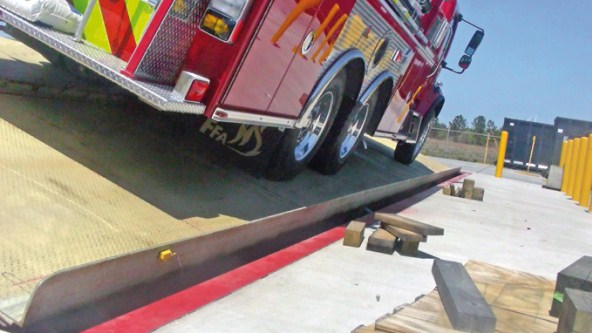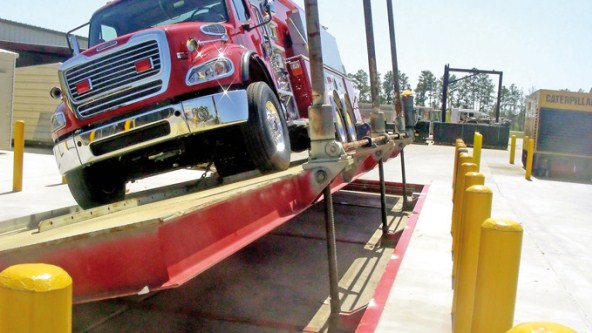Critical Angle Sensing
Ferrara Fire Apparatus uses Turck’s inclinometer for tilt testing to make sure that its fire trucks are stable in the field
Firefighters put their lives on the line doing far more than running into burning buildings. Even getting to the emergency scene can be dangerous. That is why the National Fire Protection Association (NFPA) developed standards for new fire apparatus equipment used to transport firefighters. The code, 1901 Standard for Automotive Fire Apparatus, outlines the standards required for manufacturing a fire truck to ensure the firefighters’ safety.
One of these requirements involves vehicle stability to ensure that the fire truck does not roll over during operation. NFPA 1901 4.13.1 outlines the ways in which a fire truck can adhere to this standard: by tilting the truck on a tilt table to 26.5 degrees in both directions or to equip the truck with an electronic stability control (ESC) system. According to A.K. Rosenhan, a consulting engineer specializing in fire apparatus construction, testing, evaluation and failure analysis: “ESC systems are expensive, prone to problems and not available on all chassis. Plus, many drivers do not like their controls being overridden.
Though using a tilt table is a quasi-static test, it is much easier and less dangerous to conduct – and certainly much easier on the fire truck than driving around in a circle of a specified radius at a specified speed to see if you roll over.” Ferrara Fire Apparatus, a leading manufacturer of custom emergency response vehicles located in Holden, Louisiana, has been heavily involved in crash testing and safety analysis, and offers both electronic stability control systems and on-site tilt table testing for their vehicles. “Knowing that stability testing was coming with the new 1901 standard, Ferrara Fire Apparatus made the investment in a test facility at our factory, compliant with SAE 2180,” says Chris Ferrara, President of Ferrara Fire Apparatus.
Tilt Table Testing
An important component of the tilt table is to accurately measure the amount of tilt and to record other test parameters, such as body shift, for documentation and ultimate certification. After using a simple pendulum type angle indicator to gauge the tilt of the table, Ferrara chose to use Turck’s single axis inclinometer because of its reliability and ease of use. “Many driver/operators have a strong preference for tilt table testing, wanting to avoid the throttle limitations associated with ESC,” notes Ferrara.
“As gravity is pretty constant, the results of a tilt-table test are consistent, not prone to error or interpretation, and have rather graphic proof that a fire apparatus is compliant with the NFPA standard,” adds Rosenhan. “Turck’s inclinometer does a fine job of providing such data.” “It’s a dramatic thing to see some 65,000 pounds of fire apparatus, worth up to $1 million, hanging up in the air. Obviously there are chains and straps that loosely anchor the apparatus but do provide for enough movement to determine if the vehicle 'flunks' testing,” concludes Rosenhan.
- Automotive
- Inductive Couplers Ensure Precise Material Feed
- Body Detection in Automobile Production
- Reliable Skid Detection in Automotive Production
- Error-free JIS Order Picking for Bumpers
- RFID Bus Mode Ensures Quality of Lithium-Ion Batteries
- Level Measurement in Dip Coating Line
- Level Control in Central Lubrication System
- Quality Assurance on the Gluing Robot
- Tilt angle sensor accelerates platform alignment
- IP67 Hybrid Module Processes Safety Signals
- Decentralized monitoring of cooling stations
- Robot welding cells networked with Ethernet
- Monitoring the cooling circuit on welding clamps
- Flow monitoring in drum washers
- Press Shop
- Body Shop
- Paint Shop
- Final Assembly
- Powertrain
- Item-level Detection with UHF RFID
- Supply of cooling lubricant in machine tools
- Controlling hydraulic pressure in pressing plants
- Measuring process pressure on scissor lifts
- Success Stories - Automotive
- Modular Plant for Flexible and Efficient Production
- Decentralized Safety Technology for Modular Production
- Modular Conveyor System
- RFID and I/O modules for Safe Tool Changes
- Muffler Production Wired with IO-Link Junction Boxes
- Workpiece Carrier Identification in Rear Vent Production
- Weld Nut Sensing
- RFID Traceability
- RFID in Engine Production
- Bumper Production with Identification
- Solutions for Paint Shops
- Welding and Assembly Sensors
- Angle Sensors for Assembly Systems
- Tool Identification
- Unique Products on the Conveyor Belt
- RFID in the Body Shop
- IO-Link Eases Differential Gear Production
- Chemical
- excom I/O System Enables Safe Hydrogen Liquefaction
- Decentralized Automation in Ex Areas
- RFID Control of Tube Connections in the Ex Area
- Ethernet Signal Connection in the I&C Room
- Ethernet-based Automation of Modular Skids
- Ex Isolation in Modular Process Plants
- Detection of Pigs
- Remote Signal I/O
- Easy Connection of Field Devices
- Signal Processing with System I/O in the Control Cabinet
- Signal Separation with Interface Technology in the Control Cabinet
- Identification of Hose Connections
- Efficient Monitoring of Cabinets in the Field
- Monitoring of Quarter Turn Actuators
- Planning and Assembly of System Solutions
- Success Stories
- Efficient Cooling of Industrial Furnaces with Turck's FS+ Flow Sensors
- I/O System Excom Creates Space in the I&C Rooms
- Zone 2 and 22 RFID
- Efficient Testing Control
- Intrinsically Safe Field Communication
- Process Control System Partnership
- Hazardous Area Remote I/O
- Dual Valve Position Feedback
- Flexibility with Fieldbus
- Asset Management with Remote I/O
- Correct Positioning with RFID in Carbid Production
- Fast conversion in restricted space
- Energy
- Food and Beverage
- Dough Thickness Control in Rolling Machines
- Identification of Food Containers
- Detection of Valve Position
- Detection of Pipe Elbows
- Identification of Chocolate Molds
- Success Stories
- Cloud-based Maintenance for Steam Generators
- RFID Support Enables Track and Trace in Food Production
- Grist for the Mill
- Decentralized Control Modules in Cold Storage
- Track and Trace in Meat Production with RFID
- Contact-free Encoder in Potato Production
- UHF RFID in Food Distribution Center
- RFID for Chocolate Production
- Distributed I/O for Food Equipment
- Remote I/O for Distilleries
- RFID and Autoclaves
- Transparency in Chocolate Manufacturing
- IP67 Power Supplies for Conveyors
- Identification in Food Product Storage
- Logistics
- Preventing Package Jams in the Logistics Center
- Tracking Big Bags with RFID
- Access Control for Protected Areas
- Decentralized Muting of Electro-sensitive Protectice Equipment
- Fast Tag Detection at Warehouse Gates
- Preventive Maintenance on Conveyor Belts
- Detection of Transport Containers
- Level Detection in Vessels
- Identification of Cryovessels
- Identification of Mobile Containers with Handheld Devices
- Identification of Food Containers
- Tier 1 – Bumper Identification
- Collision Protection on Reach Stackers
- Success Stories
- Logistics: RFID Reduces Error Quota by 99 Percent
- Sustainable Tracking of RTIs thanks to RFID
- RFID with HF Bus Mode Eases Seed Storage
- RFID Enables Unmanned Store at Major Building Site
- I/O and Safety Modules Increase Throughput in Intralogistics
- Shipment Tracking for Raw Materials
- RFID-based Shipment Control Minimizes Errors
- RFID-based Tracking of Inbound and Outbound Materials
- Decentralized UHF RFID Solution
- Contact-free Encoder in Potato Production
- Decentralized Control Modules in Coldstore
- IP67 Power Supplies for Conveyors
- Modular Conveyor System
- RFID Solution for Warehouse
- RFID Identifies Pharmaceuticals
- UHF RFID in Food Distribution Center
- Mobile Equipment
- Condition Monitoring Sensor Automates Climate Control
- Automatic Slope Compensation
- Distribution Lines for Field Sprayers
- Angle Measurement on a Field Sprayer
- Determining the Boom Angle Position
- Two-Axis Tilt Measurement on a Combine Harvester
- Collision Protection on Reach Stackers
- Success Stories
- RFID Solution with Smart Forklifts in Automobile Production
- Safe Remote Maintenance of Irrigation and Drainage Pumps
- Access Control with RFID System
- Selective Asparagus Harvester
- Position Measurement with RFID and Encoder
- Block I/O Modules on Super Yacht
- Wear-free encoder on hopper dredger
- I/O for Dust Suppression
- Cabinet Cooling
- Quick Disconnect Connectivity
- Automation Solutions for Extreme Cold
- Remote I/O for Cranes
- Rugged Heavy Metal Lifting
- Rollercoaster Positioning
- Mobile Machinery Solutions
- Exact Height Positioning
- Critical Angle Sensing
- Angle Indicator
- Oil and Gas
- Packaging
- Decentralized RFID Package Verification
- Identification of Printing Color Cartridges
- Reliable Operation of Machines
- Monitoring of Caps in Filling Lines
- Monitoring Changeover Processes
- Identification of Test Bottles
- Level Monitoring of Ground Coffee
- Level Detection in Vessels
- Detection of Transport Containers
- Success Stories
- Pharmaceutical
- End-to-End Sample Tracking with RFID
- RFID Control of Tube Connections in the Ex Area
- Decentralized Package Verification
- Automate Modular Skids
- Ex Isolation in Modular Process Plants
- Control of Valve Interfaces
- Monitoring of Quarter Turn Actuators
- Detection of Pipe Elbows
- Easy Connection of Field Devices
- Identification of Cryovessels
- Identification of Mobile Containers
- Identification of Mobile Containers with Handheld Devices
- Identification of Hose Connections for Precursors
- Identification of Hose Connections in Sterile Areas
- Identification of Big Bags and Bioreactors
- Identification of Single-Use Applications
- Success Stories
Select Country
Turck worldwide







